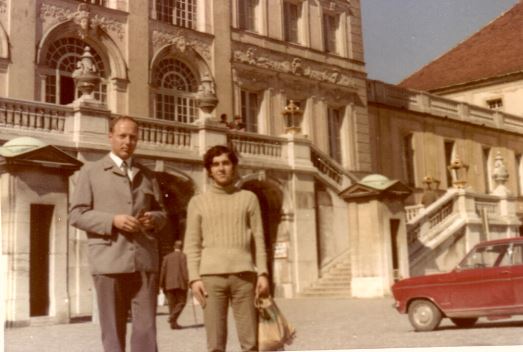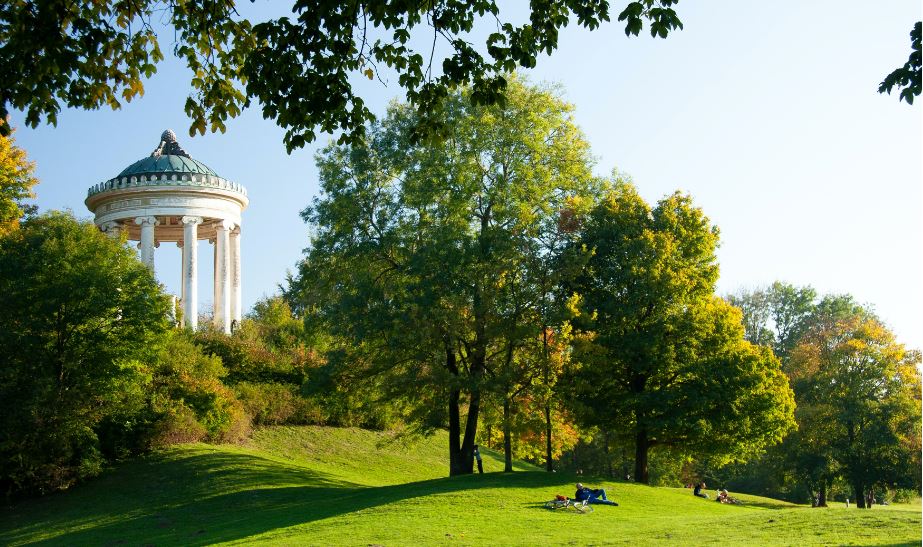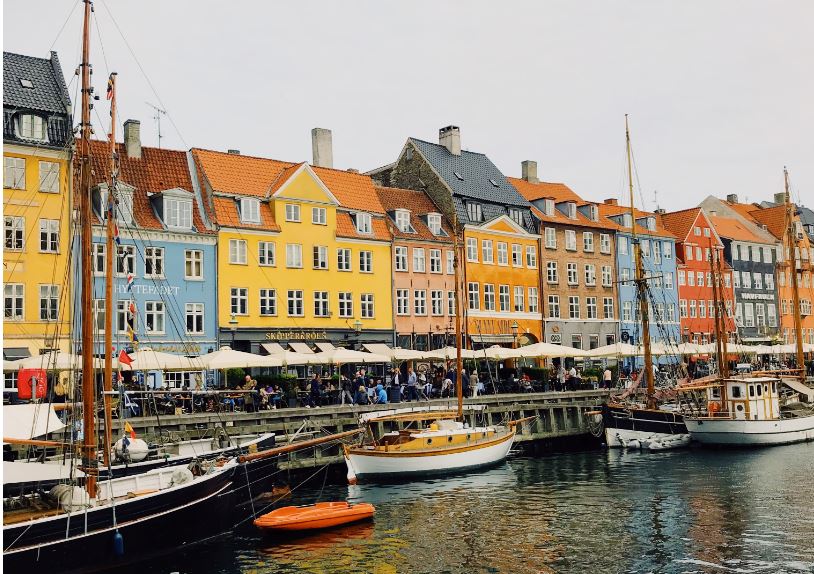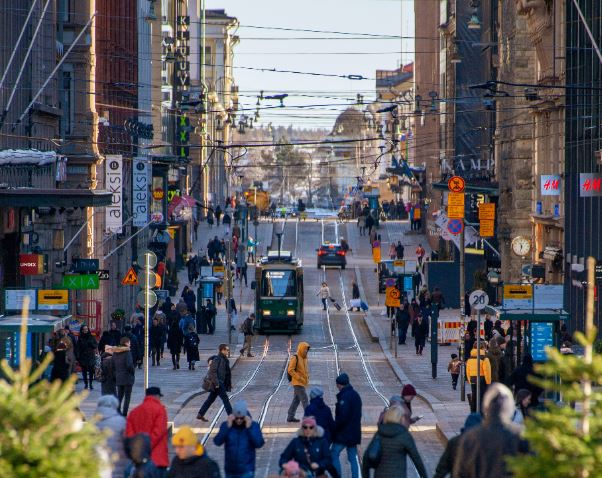RESA TILL NORDEN

RESEFÖRBEREDELSER
Since we studied in the same high school, we were good friends with my classmate Sezai at Hacettepe University. He came from a good and wealthy family and he was interested in classical music, he sang and played lute too.
We sold postcards on the street to earn money for our planned trip to Northern Europe. On the eve of Ramadan, while selling cards in front of the Turkish Airlines City terminal in Ankara, municipality police in civilian clothes appeared suddenly and confiscated our goods because in those days it was illegal to be a street peddler.
While I was trying to salvage some of my scattered cards from the street, police grabbed my stall and threw it into the police car. It was a sad moment in my life and end my peddler career that day.

ISTANBUL
At the beginning of August 1970, we packed our suitcases with Sezai and traveled from Ankara to the famous beach town Şile, located 75 km north of Istanbul by the Black Sea. We stayed with my uncle Nazmi for a couple of days and enjoyed a short sunny holiday at Kumbaba and Ağlayan Kaya beaches on the Black Sea.
My uncle was an officer at Air Forces and he joined us in the evenings and offered us dinner and delicious cakes! I bought a few famous handwoven ladies’ dresses from Şile to sell on our trip. We saw some famous singers and movie stars of those days in a Café that artists attended regularly.
Most well-known ones our childhood heroes, Zeki Müren, Neriman Köksal, and Sadri Alışık were among them although we did not dare to approach and talk to them. But it was a big surprise for us when the famous singer Zeki Müren came to me and asked: what would you like to drink my dear?

On the third day, we caught an early bus and returned to Istanbul. We left the suitcases at my grandfather’s house and walked to Grand Bazaar to buy mavi boncuk (blue-colored evil eye), alpaca rings, necklaces, etc. to sell to the youngsters and hippies on our trip.
Sezai bought an expensive beige jacket from Beyoğlu Vakko, the most expensive store on Istiklal Street, and went to say goodbye to his fiancée Miss Dizi who worked at a bank in Çarşıkapı, Istanbul.

BLÅ MOSKEN PÅ SULTANAHMET-TORGET
I walked to the Sultanahmet Square and visited the world-famous Blue Mosque, built by architect Sinan’s student Mehmet Aga at the request of Sultan Ahmet in 1609-1617.
Then I visited Alman Çeşmesi-Deutscher Brunnen-German Fountain in the end of old hippodrome. It was built in Germany then transported piece by piece to Istanbul by train and assembled in its current site when Kaiser 2. Wilhelm visited Istanbul in 1898. This beautiful fountain’s octagonal dome has eight marble columns, and the dome’s interior is covered with golden mosaics.

ORIENT EXPRESS TÅG
We placed our suitcases in an empty compartment and the bag with the pastry and baklava that my grandma gave us, and the train set off. To our surprise, the train was going very fast and took no time to pass those Yenikapı, Zeytinburnu, Bakırköy, Yeşilköy stations and leave Istanbul behind…
We fell asleep after the conductor has checked our tickets. We woke up at the Greek border in Uzunköprü, Edirne when the Turkish police entered the compartment and stamped our passports. The train departed, but just after 20 minutes stopped again. We were at the Pition station in Greece.
TURKIET GREKLAND OCH BULGARIEN
It was the Greek Border Police’s turn to check our passports and depart again. It did not take too long to reach the Svilengrad station in Bulgaria. It was amazing to pass three borders within an hour or so! We fell asleep again after the Bulgarian policemen checked the passports and left the train.
When we woke up in the morning, the train was at Sofia station, the capital city of Bulgaria. We bought Bulgarian pastry and a few apples from vendors on the platform. While the train was departing for Belgrade, colorfully dressed Turkish-speaking villagers got into the wagon.
They spoke loudly to each other and with us all the time and asked where are we coming from and what are we going to do in Almanya (Germany)? We offered them the Turkish delight my grandfather bought for us at Istanbul’s main railway station. They got out an hour later at the first station. I said to Sezai that they looked like gypsies (so-called Romani people) and we both checked our wallets immediately. Everything was ok.
It was in the afternoon when we arrived in Belgrade on the second day of the journey. We bought soft drinks from the buffet at the station.
A Yugoslavian young man named Marko got into the compartment from Belgrade. He told us that he went to Munich Maximilian University with good English. “Are you a Bosnian, a Serbian, or a Croatian?” I asked. He was Croatian. He gave his address and requested us to send postcards to him wherever we go.
We were approaching Munich at noon the next day. Green uniformed German policemen got on the train. Since there was no visa application at that time, they checked our passports, looked at us, and asked: “where we would stay in Munich?” When we said “Schloss Nymphenburg Palace”, they smiled and said “sure, we too stay there sometimes!” Finally, Border Police said “Guten Reise-Have a good trip!” The whole trip from Istanbul to Munich took two days.
I with Sezai was going to stay in Munich for two nights in the residence of our mutual friend, museum chief Ernst Götz almost as old as my father. We met Ernst last year in Ankara when he asked us how to go to the Hittite Museum. We went with him to the museum and paid his entrance fee. Then we ordered a meal for us and our guest in a kebab restaurant.

SCHLOSS NYMPHENBURG
A month ago, when we informed him that we were coming to Munich, he posted us a postcard and said that you can stay at my staff flat in the Nymphenburg Palace. So when we said to the German Border Police, we will stay in a Palace we were not really joking!
We went to the Information desk in front of the München main railways station Hauptbahnhof and queued to ask which tram to catch to Schloss Nymphenburg Museum Palace. The queue was long and many people consulted and bought tickets, and transactions were taking pretty long time.
I tried to jump the queue, went to the box office, and asked the clerk in English: “We would only ask which tram goes to the Nymphenburg Palace. Could you please tell…?” The lady interrupted me, gave me a nasty look, and told me “go to the line – line up!”
It was really taking too long just to get know which tram goes to the palace! This time Sezai went to the box office and tried his luck. The lady was equally angry with him and said: “I have already answered your friend, wait for your turn!” An hour later, when our turn came, we asked the same question again. She said in german: “Nummer Sieben!” This probably was our “First German discipline lesson” in our lives…

Schloss Nymphenburg is a Baroque palace built in 1664-1675, for the king of Bavaria. Together with its park, it constitutes one of the premier royal palaces of Europe. Its frontal width of 632m even surpasses Versailles Palace in Paris. The Nymphenburg Palace served as the summer residence for the former rulers of Bavaria. The palace, together with its park, is now one of the most famous sights of München.
Our friend Herr Ernst seemed surprised to see us with suitcases in our hands. He showed us the room we should stay in, and said: “you can do some sightseeing the rest of the day, but I will take you to a Pizzeria in the evening”. We visited the Palace, the museum, and its surroundings.
Munich was a well-planned, green, and beautiful city, the only thing missing was that it was not by the sea. Workers were working in many parts of the city, and trucks were carrying earthworks. Ernst told us that the municipality was trying to get the Metro stations ready for the 1972 Olympics! In the evening Ernst offered us pizza at Pizzeria Italiano close to the Palace.

ENGLISCHER GARTEN
We got out early the next morning. We bought bread, cheese, and honey from the market and had breakfast in the park. As Herr Ernst recommended, we went to the famous Englischer Garten of Bayern and toured the magnificent park all day. We saw a dozen of long-haired hippies, with guitars, who set up tents in the park! They were playing their music and collecting tips from the people.
On Saturday morning, Herr Ernst had to go to his home in Würzburg and he gave us a lift. He drove us by his VW auto for three hours and stopped at a gas station on the way. We showed our appreciation by offering him breakfast at Café. We gave him a few small gifts for his children and thanked him for everything!
ÄKTA TSYK KAMERA
While waiting for the train to Frankfurt, I bought a genuine German camera from the Foto store. We arrived in Frankfurt in an hour by train and walked to the Jugendherberge youth hostel where we would stay overnight. Tomorrow we would have a long way to go in the direction of Hamburg.
The next morning we went early by tram to the Autobahn junction of the northern highway. We went to the right side of the autobahn and tried our luck to get a lift! While we were waiting, a young couple, a girl and a boy came ahead of us and started Autostop-hitchhiking. Dozens of cars were passing fast, but it was as if they were accelerating when they saw us!
The young couple was clever, the girl was doing the hand rising, the guy was stepping back keeping a low profile. Before long, a car stopped, the guy appeared out of obscurity and they both hopped in the car. Our hands were tired from hitchhiking and we were taking turns raising hands. Nobody was interested to take two young boys…
BIELEFELD
While we were just hopeless and talking about returning to the city and getting on the train, a white car braked hard and stopped 100 meters away. We ran like crazy with the suitcases to that car. A handsome German man took our suitcases into the luggage. Sezo sat in front and I sat back in the new smelling car!
“My name is Manfred Schwartz but my friends call me Blacky,” he said. His father had a furniture company in the city of Bielefeld, he was going there. He looked like a wealthy man. He was driving pretty fast in this brand-new German car with 4 rings painted on the steering wheel.
We arrived in Bielefeld in the afternoon and Blacky bought us a meal and we visited a few cafés and bars. After drinking a nice milky German coffee and eating Westphalian buns, he drove us with his Audi to the youth hostel Jugendherberge in the forest. Herr Schwartz came to the hostel with us. While he was talking with a pretty lady at the reception, we looked around the hostel facilities.
JUGENDHERBERGE
Schwartz was gone when we went back to the reception after touring a few minutes around the garden and the pool. We were so sorry that we did not have the opportunity to say thank you and goodbye! We slept well in this youth hostel in the famous black forest and had a tasty breakfast in the morning.
When we went to the reception to pay for the accommodation, I said: “One double room and two breakfast, how much Deutsche Mark? The receptionist lady said “Nichts-Nothing!” and continued: “Your friend Herr Schwartz who brought you here yesterday paid it all in advance!”
We were completely surprised! We had never seen such kindness, friendship, and generosity in our life. The sayings we used to hear in Turkey, “When a German couple gets on a tram, each pays their own ticket” were false!

DANMARK
We bought train tickets from Bielefeld Hauptbahnhof to Kiel via Hannover and Hamburg. We were sad that we couldn’t say goodbye and thank our German friend Herr Schwartz!
It was evening when we arrived in Kiel on the Baltic Sea coast in Northern Germany. We boarded the last ferry to Denmark. Danish young people we met on the ferry said they buy tobacco products from the Tax-Free store on the ship and sell them at a higher price in Denmark.
We also bought each two cartons. The ship arrived at Bagenkop port late at night. We slept a few hours, sitting on a chair in an open garage, like many other young passengers.
TOBAKSSMUGGLING
Sezai exchanged the two cartons of tobacco he bought from the ship with a suitcase at the bag shop in the morning. Then we went to a tobacco kiosk, showed my two cartons of cigarettes to the bearded shopkeeper and said: “Would you buy these?”
He looked at me for a long time and said, “This is smuggling, if I want to, I can call the Police now and get you arrested; but if you leave these to me, I will pay the tax-free price you got from the ship!” We took the Danish Crowns he put on the table without counting and quickly moved away.
LOTTAS FAMILJ I NAKSKOV
We went to visit Sezai’s penfriend Lotta in the town of Nakskov, on the island of Lolland. We planned to have a coffee with her and continue on our way to Denmark’s capital city, Copenhagen. We walked to Lotta’s address. A kind man opened the door of the villa.
“My name is Harald, I know you would visit us. My daughter Lotta went out with her boyfriend, but you two can stay with us for dinner ”he said. We looked at each other with Sezai! Of course, we accepted this kind invitation, and we with Lotta’s father and mother sat at the table and enjoyed the dinner. When I said that we had a warm meal for the first time after Bielefeld, the lady brought a round cake to the table after dinner and we ate it all.
Mr. Harald: You seem tired, there is an empty room in our house. You can sleep with us tonight, tomorrow morning I will drive to Köbenhavn, and I can take you with me. If you want you can stay in our family’s summer cottage near Kastrup airport for a few days.

KÖPENHAMN
Lotta’s father Harald woke us up in the morning and while the residents were asleep, the three of us set off early and arrived at Solrödstrand after a couple of hours’ drive. The gentleman took the key from the secret place under the door and we entered the cottage consisting of two rooms.
He showed us around the house and explained: “Go ahead to the seaside and see the sandy beach; You can get to the center of Copenhagen by train in half an hour. When you are leaving the cottage, clean up the house and leave the key where we got it under the door, Hej Hej ”and he left.
DEN LILLA SJÖJUNGFRUN OCH TIVOLI
The next day, we washed our shirts and underwear and walked to the empty windy beach. Then we took the train and went to the center of Copenhagen. It was a neat and cute capital city. We saw the bronze statue of the mermaid, the symbol of the city, and visited Tivoli Gardens, famous for its amusement park.
The next morning, we ironed our clothes and went to the city again. We entered a local Travel Agency ‘Rejsebureau’ and asked for tickets to Stockholm. Our original travel plan was to travel first to Stockholm, praised as the most beautiful city in Northern Europe, stay there a few days and visit world-famous sightseeings of the city such as National and Nobel Museums, Medelhavsmuseet, Drottningholm’s Palace, and a day tour to Stockholm’s Archipelago.
GUSTAV VI ADOLF -KUNG AV SVERIGE
We thought we might see Swedish king Gustav Adolf in Stockholm city if we had good luck! After a few days in Stockholm, we should take a ferry to Helsinki. But the Danish travel agent told us there’s no ferry to Stockholm but day and night trains. Instead, she offered us a direct ferry to Helsinki with student fare which would depart the next day. So we, unfortunately, skipped Stockholm from our itinerary and bought student tickets for the Helsinki ferry.
Later, while we were buying food at the market, we saw in a shop a Turkish-made Paşabahçe jug. I said “they have plenty of glasses in his summer house, but no jug. What do you think if we buy it to the cottage as a thank you? Sezai said “good idea” and we got the jug.
NYHAVN OCH TUBORG-BRYGGREIET
We toured the historical Nyhavn harbor full of fishing boats and restaurants, the main sights of Copenhagen, and visited the Tuborg brewery.
Tuborg organized tours for tourist groups accompanied by a guide around the brewery and alcoholic or non-alcoholic beer was served to the guests in the last hall. We chose non-alcoholic beer, but the pungent smell of beer, reminiscent of the smell of urea in the hall, bothered us. We tasted the beer and returned to Solrödstrand, 30 km away from the city center.

M/S FINLANDIA TILL HELSINGFORS
On our last day in Denmark, we cleaned the inside of Mr. Harald’s cottage and its garden. We put the jug on the table and wrote “Thank you for everything” in English on the package. We locked the door, put in the key, and went to the city to board the ship. From the Skandinavienkai harbor, we boarded a modern ship called “Finlandia”.
Most of the passengers were German and Danish tourists and Finns returning to Finland. As there were many young people on the ship, a one, and half-day voyage passed quickly. We sold a few hand-woven ladies’ dresses in the ship’s cafeteria and earned two hundred Marks. We slept in Pulman seats at night.
I have an interesting memory in my mind from this boat journey. We asked the Finnish youngsters to teach us a few words in Finnish such as: Hello, How are you, Thank you… They wrote those Finnish words on paper and gave it to us.

HELSINKI -HELSINGFORS
The next day, as the ship approached Helsinki through the islands, we watched magnificent views from the deck. At the passport control, I looked at the paper written by Finnish friends on board the ship yesterday and said to a middle-aged policeman:” Hello-Voiettä!”.
The police looked at me and said: “What, what did you say”? I show the paper in my hand and said: “Hello means “Voiettä” in Finnish, right”? Look, young man: “Someone made you a prank. What you said means “Oh boy!” he said: I felt so shy and said: Excuse me, sir”
We walked from Eteläsatama harbor to Nuorisomaja-Youth Hostel next to the Olympiastadion tower, where the 1952 Helsinki Olympics were held. We signed up for the most affordable 6-person bunk room, left the suitcases, and went out.
HELSINGFORS-ÖSTERSJÖNS DOTTER
My first impression of Helsinki was: green parks sprinkled here and there and lined around wide avenues were the state buildings and some modern buildings, reminiscent of the neoclassical architecture of about 100-200 years old.
Now I understand why the Europeans name Helsinki “the beautiful daughter of the Baltic Sea!” The city reminded me of typical German cities, but the shores and islands around added a unique natural beauty to the capital of Finland!

Copyright © 2021 All rights reserved – Kaikki oikeudet pidätetään

